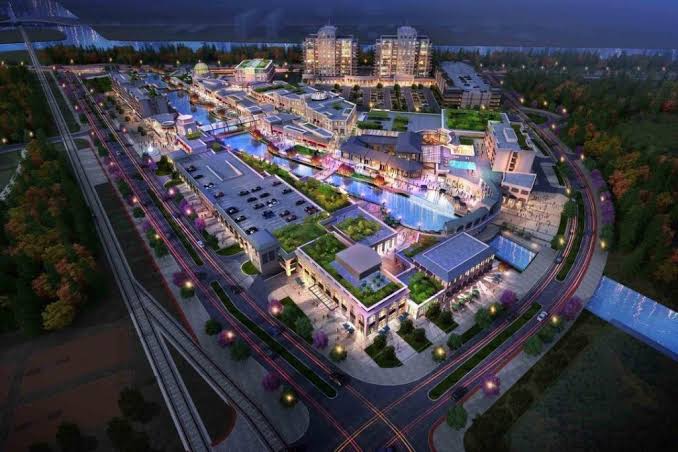Revised Niagara Falls Development Project Moves Forward with Community Support
Thundering Waters Development in Niagara Falls Becomes Less Contentious After Years of Debate
After nearly a decade of controversy and passionate debate, the development proposal once known as Thundering Waters in Niagara Falls, Ontario, has taken on a new identity—and a much less contentious one. Rebranded as the Riverfront Community, the large-scale project has undergone major revisions and compromises, earning cautious approval from environmental groups and growing support from residents and city officials.
What was once a flashpoint for environmental activism and community division is now being viewed by many as a model for how urban development and ecological conservation can coexist through collaboration, transparency, and adaptive planning.
A Controversial Beginning
The development, originally referred to as Thundering Waters, was proposed by GR (Can) Investment Co. Ltd., a Canadian subsidiary of a Chinese investment group. The plan envisioned transforming approximately 484 acres of land near the Thundering Waters Golf Course into a mixed-use community with residential homes, commercial buildings, hotels, retail spaces, and public amenities.
However, what immediately sparked outrage was the fact that over 200 acres of the land was made up of provincially significant wetlands, home to numerous rare plant and animal species. Environmentalists and concerned citizens saw the proposal as a major threat to the local ecosystem, particularly to sensitive hydrological areas and wildlife corridors that fed into the Welland River.
Protests emerged quickly. Environmental groups like A Better Niagara and Niagara Peninsula Conservation Authority (NPCA) watchdogs criticized the project’s early environmental assessments. Activists even camped out on the land in 2018 to draw attention to what they saw as an attempt to bulldoze through both forest and public opposition.
Revisions in Response to Public Outcry
Following widespread pushback and environmental reviews that flagged the initial plans as risky and incomplete, the developers went back to the drawing board. Between 2019 and 2023, GR (Can) Investment and its planning team made substantial changes to the project’s scope, environmental protections, and public engagement strategy.
The most significant shift came in 2023, when the project was rebranded as the Riverfront Community. With the new name came a renewed commitment to environmental stewardship. The revised plan committed to preserving more than 200 acres of wetlands and natural areas. Additional measures included:
Implementing biodiversity offsetting, which involves recreating wetland functions elsewhere on the property to compensate for any disturbed areas.
Adding green infrastructure such as stormwater ponds, permeable surfaces, and pollinator-friendly landscaping.
Developing public green spaces, trails, and pedestrian connections throughout the site.
Consulting with Indigenous communities, including the Mississaugas of the Credit First Nation, to incorporate land-use concerns and cultural heritage protections.
These changes shifted public perception of the project, transforming it from a perceived threat to an opportunity for environmentally-conscious urban growth.
—
City Involvement and Planning Oversight
The City of Niagara Falls played a key role in the evolution of the project. In 2022, the city approved the Thundering Waters Secondary Plan, a document that established guidelines and expectations for any development within the area. This included strict policies around environmental impact mitigation, tree preservation, and sustainable urban design.
City planners worked closely with the developers and regional environmental experts to ensure compliance with both provincial and municipal policies, including the Provincial Policy Statement and the Niagara Official Plan.
Mayor Jim Diodati, initially criticized for his support of the project in its early days, has since emphasized the importance of compromise and the value of sustainable growth.
“We can’t pretend growth isn’t coming to Niagara Falls,” he said at a 2024 town hall meeting. “But how we grow, and what we protect in the process, is what will define us.”
—
Economic and Community Benefits
Proponents of the Riverfront Community project highlight not just its environmental reforms, but its potential to bring significant economic and social benefits to Niagara Falls.
The project is expected to:
Create over 2,000 jobs during and after construction.
Offer a variety of housing options, including affordable units, seniors’ housing, and long-term care facilities.
Attract tourists and new residents with hotels, restaurants, retail outlets, and public riverfront amenities.
Generate new municipal revenue through property taxes and business growth.
Niagara’s growing population, fueled by immigration and people relocating from the Greater Toronto Area, has put pressure on local housing markets. The Riverfront Community is seen by some as a much-needed addition to the city’s residential stock.
—
Environmentalists: From Opposition to Engagement
Not all environmental advocates have become supporters, but many have changed their approach. Groups that once called for the complete cancellation of the project are now choosing to engage rather than resist.
“We’re still watching closely,” said Lynn Wells, spokesperson for the environmental group Preserve Our Wetlands Niagara (POWN). “But we’re encouraged by how far the developers have come. If we’re going to have development—and we know it’s coming—this is how it should be done: carefully, transparently, and with real accountability.”
The project has also benefited from the input of third-party ecological consultants who are tasked with monitoring and enforcing mitigation efforts throughout the various phases of construction.
—
Indigenous Participation and Reconciliation
In recent years, Indigenous involvement in land development processes has become a critical component of responsible planning. The Riverfront Community has included consultation with local Indigenous groups, particularly the Mississaugas of the Credit First Nation (MCFN).
Representatives from MCFN have worked with planners to identify culturally significant areas and ensure that any archaeological sites are properly surveyed and respected. While some community members have expressed concerns about development on ancestral lands, others see the process as a step forward in reconciliation and collaboration.
—
A Blueprint for Future Development?
With Ontario’s population expected to continue rising over the coming decades, cities like Niagara Falls will be tasked with accommodating growth while preserving natural assets. The Riverfront Community, for all its early controversy, is being looked at by some planners as a case study in adaptive development.
Urban planning experts have praised the project’s revised model for its integration of conservation, economic development, and community building.
“This is what smart growth looks like,” said Dr. Karen Robertson, an urban development researcher at Brock University. “It’s not perfect, but it’s a real-world example of how community pressure, political will, and developer flexibility can lead to better outcomes.”
—
Conclusion
The transformation of the Thundering Waters proposal into the Riverfront Community marks a significant shift in the tone and direction of Niagara Falls’ development strategy. Once a battleground for environmental justice and corporate ambition, the project has become a symbol of compromise and progressive planning.
While construction is still in its early stages and concerns remain, the evolution of this project demonstrates that public opposition does not have to result in cancellation—it can lead to better projects.
As Niagara Falls grows and changes, the lessons learned from this once-divisive proposal will likely shape how future developments are approached, debated, and ultimately built.
–






